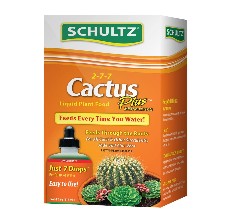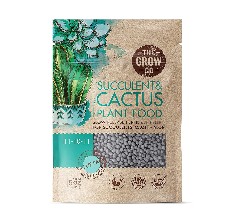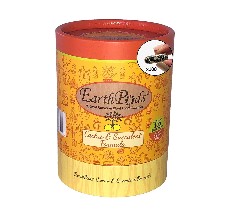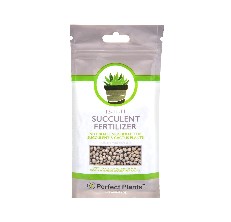- Flowers & PlantsVegetablesOur content is meticulously curated through independent research, testing, reviews, and AI-driven recommendations, all designed to present you with the finest product choices. When you make a purchase through our links, it could result in us earning a commission.
The Best Succulent Plant Foods To Feed Your Succulents
 Last updated: Mar 12, 2024
Last updated: Mar 12, 2024Extremely resilient and delightfully pretty, succulent plants are unsurprisingly loved by novice and veteran plant parents alike. This plant group has evolved to store large amounts of water in the leaves and stems. So, they don’t really mind when you forget to water them for some time. However, like all living things, they do need some sort of sustenance. So, join us as we take you through the best foods for succulent plants in 2024 that are sure to keep your greens healthy and happy.
These plant foods, also called fertilizers, are a blend of organic and/or natural nutrients that sustain the plant and enhance its growth. We will be giving you a complete 101 to these plants’ nutrition and describe the elements of good succulent fertilizer. For now, let’s start things off with our team’s review of the top-rated foods for succulents that are currently available.
Show contentsMost Premium Succulent Plant Foods Worth Considering- Schultz Cactus Liquid Plant Food - Best Overall
- The Grow Co Succulent Food - Runner Up
- EarthPods Cactus & Succulent Plant Food - Honorable Mention
- Miracle-Gro Succulent Plant Food - Contender
- The Perfect Plants Succulent Plant Food
A Comprehensive Buying Guide to Succulent Plant FoodA Comprehensive Buying Guide to Succulent Plant Food
Succulents are great for both people that are new to growing plants, as well as veteran plant parents. Because they are so low maintenance, they are easy for almost anyone to keep alive. However, even though they are low maintenance, they still require some level of care. Let’s now look at how you can go about buying the food necessary for the sustenance and growth of your succulents.
What Do Succulent Foods Contain?
Succulent fertilizers, like any other plant food, consist of three main ingredients:
- Nitrogen
- Phosphorus
- Potassium
These components are labeled on the plant food as NPK. Those are their chemical formulas written together (N for nitrogen, P for phosphorus, and K for potassium.) Fertilizer manufacturers will list the NPK ratio, which signifies the proportion of N, P, and K in the plant food. Let’s now take a brief look at the three main ingredients and how they enhance the growth of succulent plants:
Nitrogen
Good ol’ nitrogen helps stimulate leaf and stem growth and is a vital nutrient for your succulent. If your plant’s leaves are turning yellow, you should look for a fertilizer with a relatively high ‘N’ ratio. If the leaves of your plant do not appear to be yellowing, anything from 5-15 should be a safe bet.
Phosphorus
A deficiency of phosphorus in plants is usually signified by greenish-purple leaves. This nutrient helps with stem and flower growth, and should be in the range of 5-15%. It’s also completely fine if the ‘P’ ratio is more than the ‘N’ and ‘K’.
Potassium
Potassium, or ‘K’, helps your little succulent fight off germs and protects it from diseases. As a general rule of thumb, you should seek out the same ratio of potassium as nitrogen. However, it’s worth getting more potassium-focused fertilizer if your leaves are turning brown on the edges.
Buying Tips for the Premium Quality Succulent Foods
Now that you know all about the main components of succulent food, here are two tips to help you make a more informed decision when in the market for one:
A healthy blend
NPK aren’t the only substances that plant foods contain. The best ones, like the ones in our best-of list, also boast rich nutrients such as microbes, minerals, and humic acid, that work phenomenally alongside NPK to promote plant health and growth.
Safety
Do you know that some fertilizer blends are pretty toxic for your plant’s leaves, even though their sole purpose is to… well, promote their growth? Intrigued? Well, it’s all about direct exposure.
If you apply such plant foods directly to your succulents, their leaves may be harmed. So, make sure that either your new plant nutrient will not cause damage upon contact with the leaves, or be careful when applying it and put it only on the potting soil. Moreover, you should also choose fertilizers that are safe for the environment and come in recyclable packaging.
What Are the Different Types of Succulent Foods?
Broadly speaking, succulent foods come in three different types:
- Liquid fertilizer for succulents
- Capsule fertilizer for succulents
- Granulated fertilizer for succulents
Their differences stem from their form. Let’s now take a look at what makes each type different from the other:
Liquid food for succulents
Liquid fertilizers for succulents usually come in spray or dropper bottles. You simply apply them on the plant’s leaves or on the soil, as per the manufacturer’s instructions. Just make sure that your succulent leaves do not end up dripping with liquid fertilizer, as overdosage may do more harm than good.
Capsule food for succulents
Plant foods in the capsulated form are meant to be burrowed into the soil. It then breaks down and releases the nutrients over time. The capsule’s small form factor makes it extremely handy and easy to use. You can even break the capsule and sprinkle the fertilizer over your plant, if it is safe to touch the leaves.
Granulated food for succulents
Fertilizers in the granular form are the most popular type of succulent food. As far as application goes, you simply scratch it into the soil and then water the soil to activate the nutrients.
All three types of plant foods for succulents may be organic fertilizers or non-organic fertilizers. Organic fertilizers may contain worm castings or fish emulsion. Non-organic fertilizers usually only contain a few chemical compounds to support plant growth.
How Did We Choose the Top-rated Succulent Foods?
When shortlisting our best-of list, we made sure that the plant food boasted these three factors:
Longevity
We understand that you’d like to keep your little succulent for as long as possible. So, we made sure that its food stayed with you for a long time as well. We made sure that the fertilizer came in generous serving sizes and in packages that ensured easy storage and longevity.
Scent
If there’s one thing that we associate fertilizers with, it is that awful stench. So, we made sure that all our top picks were either scent-free or boasted a pleasant smell.
Application
Caring for your greens shouldn’t be hard. So, our team also made it a point to only shortlist plant foods that were easy to use and apply to your plant and soil.
If you are looking for more tips on how and when to fertilize your succulents, check the following video.
Most Premium Succulent Plant Foods Worth Considering
1Schultz Cactus Liquid Plant Food
– Best OverallSchultz provides the best quality plant food for the widest range succulent variants like cacti, jade, and aloe vera at a very low price. The high NPK ratio of 2-7-7 ensures the healthy growth of the plants by nurturing them through their roots. The best part about this succulent plant food is that it comes with a dropper bottle, which ensures the accuracy of the dose by providing user control.
This succulent plant nutrition is great for both indoor and outdoor plants. Schultz suggests watering indoor plants with seven drops of this plant food per quart of water, each time you water. However, you must be careful at the time of application, as over-fertilizing the plants may damage them.
Pros- A high NPK ratio for superior growth
- Comes with a dropper bottle for easy measuring
- The liquid formula allows for a convenient application
Cons- Overfeeding might cause harm to the plants
2The Grow Co Succulent Food
– Runner UpThe Grow Co succulent plant food is powered with a blend of nutrients and a gentle NPK ratio to feed several succulent plants such as aloe, jade, cacti, echeveria, and desert rose. It is known to support the development of a strong stem and roots, as well as promote saturated colors and the growth of blooms.
This succulent plant food is the perfect health booster for your indoor and outdoor plants. It is a great alternative to liquid sprays, and instead comes in the form of grainy particles, making it particularly ideal for plants that require less water. All you need to do is insert the particles in the soil, water them, and watch your plants grow beautifully.
Pros- Feeds a wide range of succulents
- Easy application
- Lasts for a long time
Cons- Can only buy in a small quantity
3EarthPods Cactus & Succulent Plant Food
– Honorable MentionThe EarthPods’ plant food is made to promote strong root and stem development and encourage saturated colors for various succulent plants like aloe vera, cacti, jades, and others. It is formulated with all-natural ingredients, including plant nutrients, useful soil microbes, growth hormones, minerals, and humic acids.
You’ll get 100 highly concentrated capsules per tube, so one container can last for up to six years. Also, this plant food is kid-friendly and environment-friendly due to its recyclable properties and biodegradable container. In addition, the application of this product is quite simple. You just need to directly insert the capsules into the soil. You can also open and sprinkle them all over the plant, in case there are pebbles or other large media in the pot.
Pros- Filled with many organic ingredients
- Made from highly concentrated formula, can last up to six years
- Environment-friendly composition and recyclable container
Cons- A bit pricey, but definitely worth it
4Miracle-Gro Succulent Plant Food
– ContenderThe Miracle-Gro succulent plant food is one of the top-rated fertilizers that works for all types of succulents. With an effective NPK ratio of 0.5-1-1, it feeds the plants and gives them a health boost immediately upon application.
Due to its consistent formula, this succulent plant food can be either applied directly onto the roots, or in diluted form on the plant. The container includes a pump so you can also measure how much of the fertilizer is to be applied. On the package, it is suggested that you use two pumps for small pots and five for larger pots, every two weeks. Just make sure that the fertilizer doesn’t touch the leaves – and if it does, you must rinse it off quickly to avoid any damage.
Pros- Works for all succulents
- Feeds plants immediately upon application
- Can be applied directly or mixed with water
Cons- Might harm the leaves upon direct exposure
The Perfect Plants professional-grade succulent plant food is a great choice for feeding all indoor and outdoor succulents. It comes in a granular form, so you can sprinkle the pellets evenly on the soil and water them. The effective mix of nutrients ensures the nourishment of roots, helps the plant produce saturated colors, and promotes healthy stem development.
Due to its balanced NPK ratio of 13-11-11, this fertilizer makes it very unlikely that you will accidentally overdose your plants. This succulent plant food comes in a heavy-duty ziplock pouch, which makes it easy to store. Perfect Plants recommends you use their succulent plant food every six months, so one package will last you for years.
Pros- Integrates an effective mix of nutrients
- Durable formulation
- Convenient to use
Cons- An overdose might burn the roots
People Also Asked
Q: Do succulents need plant food?A: Yes! While succulents are some of the toughest plant groups, regular fertilizing once a month or so can do wonders to their growth and lifespan. Just make sure that the fertilizer isn't too strong, as that might burn your poor plant. A balanced NPK ratio between 5 and 15 is considered a safe bet.
Q: How do I use succulent fertilizer?A: The application of succulent plant food will vary from product to product. Granular foods should be scratched into the soil and then bathed with some water. Capsulated fertilizers can be burrowed into the soil, or sprinkled over the plant if the soil has too many pebbles. Liquid solutions should be applied as per the manufacturer's instructions.
Q: What is the best succulent plant food?A: All our shortlisted succulent plant foods provide a phenomenal price to performance ratio and can be purchased without batting an eye. However, if we were to select one as our top pick, we would definitely go for the Schultz Cactus Liquid Plant Food. Its rich NPK ratio of 2-7-7 is specifically built for succulents. This liquid plant food comes in an ergonomic dripper bottle that ensures proper dosage and prevents your plants from getting burnt.
The Garden Gate Review Team’s product reviews and in-depth guides are here to help you choose the best products for a beautiful and bountiful garden and backyard. The content is created by The Garden Gate Review Team. Garden Gate’s editorial staff is not involved. Garden Gate is reader-supported: When you buy through links on our site, we may earn an affiliate commission. The Garden Gate Review Team is composed of authors, editors, and gardeners. Artificial Intelligence (large language models) may have been used in the research and creation of the content. Please reach out to aimperiapt@gmail.com with any questions regarding product testing or specific articles.




